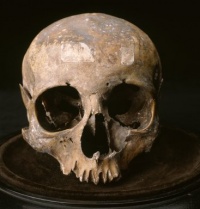George Buchanan

George Buchanan (1506-82), was a Scottish Renaissance humanist, poet and reformer, widely regarded as the finest writer in Latin of his century.
Biography
Buchanan studied and taught in several European universities. On his return to Scotland he lent his support to the reformers, often at grave personal risk. He was installed as tutor to Mary, Queen of Scots, but subsequently accused her of complicity in Darnley's murder in the tract Detectio Mariæ Reginæ. Following Mary's abdication, he was appointed Keeper of the Privy Seal of Scotland and spent eight years as tutor to the young King James VI to whom he proved a notoriously hard but effective task master.
Works
Internationally, Buchanan remains best known for the tragedies, Baptistes and Jephthes, perhaps the most innovative and influential works of neo-Latin drama, and for his paraphrases of the psalms, which went through over 100 European editions and were set to music by Jean Servin and Statius Olthof. His major prose works include De Jure Regni apud Scotos, a treatise on kingship written for the young James VI which argues against the divine right of monarchs, and Rerum Scoticarum Historia, a history of Scotland which includes a tribute to Bishop Robert Reid, founder of the University of Edinburgh.
Buchanan and the University of Edinburgh
As the leading scholar among the Scots reformers and as tutor to the king in whose name it was founded, Buchanan has always been held in particular honour by the University of Edinburgh. His skull was formerly on display in the University, but has been kept in the Anatomical Museum since 1817. It has been part of the University's collection since the very beginning of its history. Thomas Morer (1651-1715), author of A Short Account of Scotland (1702) saw the skull 300 years ago and reported then: 'Mr Adamson, Principal of the College, being a young man of 24 years of age when Buchanan was buried, either out of Curiosity or Respect for the Dead, brib'd the Sexton some time after to procure him the head.'
The skull, marked 'Buchanan', was found in Principal John Adamson's study after his death.
Sources
- Thomas Morer, A Short Account of Scotland: Being a Description of the Nature of that Kingdom, and What the Constitution of It Is in Church and State (London: Printed for Tho. Newborough, 1702)